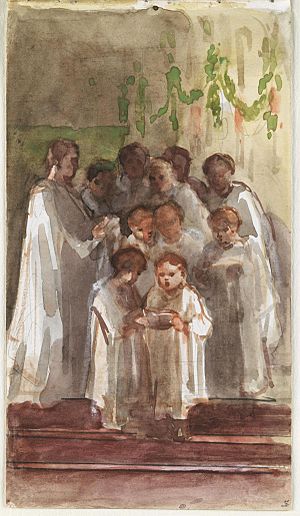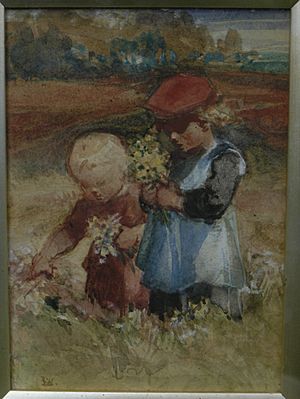Louisa Beresford, Marchioness of Waterford facts for kids
Louisa Anne Beresford, also known as the Marchioness of Waterford, was a talented artist and a kind person who helped many people. She lived from 1818 to 1891 and was known for her beautiful watercolour paintings, often linked to the Pre-Raphaelite art movement. She was also a philanthropist, meaning she used her wealth and influence to help others.
Quick facts for kids Louisa Beresford |
|
|---|---|
| Marchioness of Waterford | |
| Louisa, Marchioness of Waterford by Sir Francis Grant |
|
| Spouse(s) | |
| Noble family | Stuart of Bute |
| Father | Charles Stuart, 1st Baron Stuart de Rothesay |
| Mother | Lady Elizabeth Yorke |
| Born | 14 April 1818 Paris, France |
| Died | 12 May 1891 (aged 73) |
| Occupation | Watercolourist, philanthropist |
Contents
Her Early Life
Louisa Anne Stuart was born in Paris, France, on April 14, 1818. Her father was Charles Stuart, 1st Baron Stuart de Rothesay, a British ambassador. Her mother was Lady Elizabeth Margaret Yorke. Louisa had an older sister named Charlotte, Countess Canning.
Louisa's family owned a grand home called Highcliffe Castle. This castle was built by her father between 1831 and 1835. It was known for its unique and romantic style. The castle even included old carved stone pieces from medieval buildings in France. These pieces came from places like the Abbey of St Peter at Jumieges.
Her Passions and Art
Louisa received art lessons from a young age. This was fitting, as she was the great-granddaughter of the famous writer Lady Mary Wortley Montagu. Art, helping others, and her faith were very important throughout her life.
Even though she was a very skilled artist, her paintings were not shown in public galleries until the 1870s. She was taught by famous artists like Dante Gabriel Rossetti. She also took drawing classes with John Ruskin, a well-known art critic.
Many people believe that Louisa's beauty inspired the Pre-Raphaelite Brotherhood. This was a group of English painters who wanted to change art. She is also thought to have posed for some paintings by John Everett Millais, another famous artist.
Helping Others in Ford Village
Louisa cared deeply about the people living on her land in Northumberland. She decided to redesign the village of Ford to make it better for everyone. She even designed and built a school for the children.
From 1860 to 1882, Louisa spent 22 years decorating the school hall. She painted large watercolours on paper, which were then put onto canvas and placed on the walls. These paintings showed scenes from the Bible. What's amazing is that she used the people from the village as models for her characters!
The village school was used by children until 1957. Today, it is known as the Waterford Gallery or Lady Waterford Hall. It is a special place where people can still see her beautiful artwork.
Her Marriage and Later Years
On June 8, 1842, Louisa married Lord Waterford. His full name was Henry Beresford, 3rd Marquess of Waterford. They lived at Curraghmore House in County Waterford, Ireland. Sadly, Lord Waterford died in 1859 in a horse riding accident. They did not have any children.
Louisa continued to live a life dedicated to art and helping others. She passed away on May 12, 1891. Her grave is located next to the Church of St Michael in Ford Village. The stone for her grave was designed by the famous artist George Frederic Watts.
More About Louisa
- Sublime & instructive; letters from John Ruskin to Louisa, Marchioness of Waterford, Anna Blunden and Ellen Heaton – Virginia Surtees (1972)
- The story of two noble lives: being memorials of Charlotte, Countess Canning, and Louisa, Marchioness of Waterford – Augustus Hare (1893)
- Neville, H.M. "Under a Border tower: sketches and memories of Ford castle, Northumberland, and its surroundings, with a memoir of its late noble châtelaine, Louisa marchioness of Waterford"; Newcastle upon Tyne, Mawson, Swan, & Morgan, 1896.
- The Stuarts of Highcliffe – Robert Franklin



